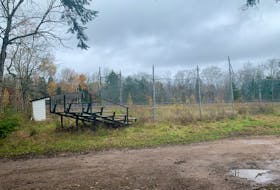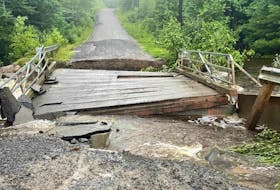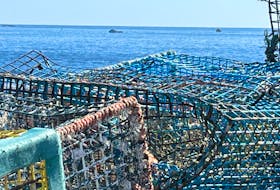A residents group made an unsuccessful foray into the courtroom to oppose Lafarge Canada’s pilot project to burn tires in its kiln at a cement plant near Brookfield.
The group — Citizens Against Burning of Tires, or CABOT, — made application to the Nova Scotia Supreme Court for a review of Environment Minister Iain Rankin’s assessment approval in July of the one-year pilot project.
After hearing the review, Justice James Chipman two weeks ago dismissed the group’s challenge of the ministerial decision. One of the five complainants said a different outcome might have been achieved had an environmental court or tribunal been tasked with handling the dispute.
“It would have been different,” said Fred Blois, who lives about 10 kilometres from the plant but joined complainants in the legal challenge who live as close as 500 metres from the Colchester County cement operation.
“As I view it, all that we were asking for was to present information to the court that would have a very different outcome on what the minister should consider and not consider,” Blois said. “We were barred from doing this and it seemed to be on a point of law. It was not for the environment.”
In January, Justice Denise Boudreau ruled that a report in support of the complainants from Douglas J. Hallett, a toxic chemical expert, would not be admitted as part of the judicial review because it was new evidence that Rankin hadn’t considered when making his decision.
When the judicial review commenced in March, Chipman quashed the complainants’ attempt to introduce seven research papers that had been referenced by Mark Gibson, the Dalhousie University professor who had completed the original laboratory work that supported Lafarge’s bid for a pilot project. The seven papers provided dissenting opinions about the environmental safety of burning tires but Chipman disallowed them because again the minister had not considered them in his decision.
“All the facts should have been there before the minister made that decision or after he made that decision he should have reconsidered because we had a different view and it was backed by some of the finest minds and the people who had the experience,” said Blois.
Those are the facts that would likely have been considered in front of an environmental court or a green bench such as those that exist in Australia, Sweden, New Zealand, Phillipines and Kenya but not in Canada, although environmental review tribunals with limited powers have been installed in Ontario and British Columbia.
Andrew Gage is a staff lawyer with West Coast Environmental Law, a non-profit organization that provides legal support for people dealing with environmental conflict.
He said a green court can usually provide better environmental decisions.
“I would go so far as to say the societies that put a high value on their environment and having strong environmental protection should certainly consider environmental courts as a model,” Gagesaid.
He said green court judges develop greater scientific expertise and knowledge of the types of environmental impacts they are looking at and how they can be appropriately handled.
Gage said Canadian courts as a general rule are “very deferential of government decisions.”
The government has elected officials and it’s thegovernment’s role to consider balanced public value versus the commercial interests of a company and therefore courts are very reluctant to intervene, he said.
Gage said courts in many countries strike a difference balance, “to view the public as having rights that it is the role of the court to protect.”
Gage said without a crystal ball, he cannot guess if green courts will ever be established in Canada.
“The closest examples we have are B.C. and Ontario. Both have specialized tribunals that consider appeals from certain environmental statutes. They don’t have the stature of a court and I don’t think that they’ve necessarily been as successful in terms of achieving ground on protection.”
Gage would not want to comment specifically about the Lafarge case but did offer speculation about how Canadian courts could play more of that protective role.
“There have been suggestions that the Canadian Charter of Rights and Freedoms, especially Section 7, the right to life, liberty and security of the person, may have a substantive content in terms of the public’s right not to be exposed to toxins.”
But he said if green courts were eventually established in Canada, if the prevailing attitude persisted in favour of deference to government, the green bench might not be very effective.
Blois thinks something has to change.
“I think the court has failed the environmental community in this particular instance and don’t ask in how many other instances along with ours.”








